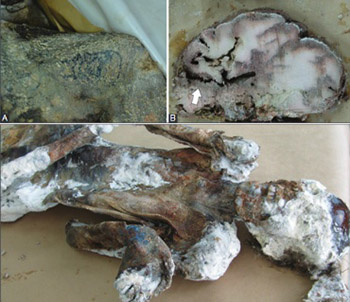Histological observations on adipocere in human remains buried for 21 years at the Tomašica grave-site in Bosnia and Herzegovina
DOI:
https://doi.org/10.17305/bjbms.2018.3343Keywords:
Tomašica mass grave, adipocere, histopathologyAbstract
The Tomašica grave-site near Prijedor in the north of Bosnia is reported to be the largest primary mass grave discovered thus far relating to the 1992–95 war. A total of 275 complete bodies and 125 body parts were exhumed from it in 2013. Post mortem examinations of the victims showed that nearly all had died from gunshot injuries but an additional striking feature was the degree of preservation of many of the bodies, even 21 years on, with skin, soft tissues and internal organs still present in abundance and gross structures clearly identifiable. Histology was performed on 68 samples of soft tissue from a total 13 bodies, on both skin and internal organs, and the degree of preservation was assessed in terms of the ability to recognize microscopic structure. Further comparison was made with samples taken a month or so later (56 tissue samples from 9 bodies, all but one different from the first group), after the bodies had been covered in salt as a means of general preservation. Generally, at a microscopic level, skin and subcutaneous tissues were better preserved than internal organs, while tissues sampled at the time of autopsy were better preserved than those sampled weeks later.
Downloads
References
Baraybar JP, Gasior M. Forensic anthropology and the most probable cause of death in cases of violations against international humanitarian law: An example from Bosnia and Herzegovina. J Forensic Sci 2006;51(1):103-8.
https://doi.org/10.1111/j.1556-4029.2005.00035.x.
Begić M, Ramić S, Ališić Z. Tomašica-masovna grobnica. 1st ed. Sarajevo: Institut za istraživanje zločina protiv čovječnosti i međunarodnog prava Univerziteta u Sarajevu; 2015. 37-46 p.
Ubelaker DH, Zarenko KM. Adipocere: What is known after over two centuries of research. Forensic Sci Int 2011;208(1-3):167-72. https://doi.org/10.1016/j.forsciint.2010.11.024.
Tumer AR, Karacaoglu E, Namli A, Keten A, Farasat S, Akcan R, et al. Effects of different types of soil on decomposition: An experimental study. Leg Med (Tokyo, Japan). 2013;15(3):149-56. https://doi.org/10.1016/j.legalmed.2012.11.003.
Forbes SL, Dent BB, Stuart BH. The effect of soil type on adipocere formation. Forensic Sci Int 2005;154(1):35-43. https://doi.org/10.1016/j.forsciint.2004.09.108.
Thali MJ, Lux B, Losch S, Rosing FW, Hurlimann J, Feer P, et al. "Brienzi" - The blue Vivianite man of Switzerland: Time since death estimation of an adipocere body. Forensic Sci Int 2011;211(1-3):34-40. https://doi.org/10.1016/j.forsciint.2011.04.009.
Tessadri R. Vivianite from the Iceman of the Tisenjoch (Tyrol, Austria): Mineralogical-chemical data. In: Bortenschlager S, Oeggl K, editors. The Iceman and his Natural Environment: Palaeobotanical Results. Vienna: Springer Vienna; 2000. p. 137-41. https://doi.org/10.1007/978-3-7091-6758-8_11.
Olympus. BX43 Upright Microscope 2018 [Available from: https://www.olympus-lifescience.com/en/microscopes/upright/bx43/].
Humayun M, Khichi ZH, Chand H, Khan O, Asadullah. Exhumation--a key to provide justice to victims of homicide: Situation in Larkana and Sukkur divisions. J Ayub Med Coll Abbottabad 2010;22(1):168-70.
Grellner W, Glenewinkel F. Exhumations: Synopsis of morphological and toxicological findings in relation to the postmortem interval. Survey on a 20-year period and review of the literature. Forensic Sci Int 1997;90(1-2):139-59.
https://doi.org/10.1016/S0379-0738(97)00154-0.
Karger B, Lorin de la Grandmaison G, Bajanowski T, Brinkmann B. Analysis of 155 consecutive forensic exhumations with emphasis on undetected homicides. Int J Legal Med 2004;118(2):90-4. https://doi.org/10.1007/s00414-003-0426-z.
Green MA. 19th-century pathology: The examination of 83 vault-interred bodies. Forensic Sci Med Pathol 2006;2(1):19-24. https://doi.org/10.1385/FSMP:2:1:19.
Szleszkowski L, Thannhauser A, Szwagrzyk K, Jurek T. The possibility of establishing causes of death on the basis of the exhumed remains of prisoners executed during the communist regime in Poland: The exhumations at Powazki Military Cemetery in Warsaw. Int J Legal Med 2015;129(4):801-6. https://doi.org/10.1007/s00414-014-1084-z.
Nushida H, Adachi J, Takeuchi A, Asano M, Ueno Y. Adipocere formation via hydrogenation of linoleic acid in a victim kept under dry concealment. Forensic Sci Int 2008;175(2-3):160-5. https://doi.org/10.1016/j.forsciint.2007.06.008.
Ueland M, Breton HA, Forbes SL. Bacterial populations associated with early-stage adipocere formation in lacustrine waters. Int J Legal Med 2014;128(2):379-87. https://doi.org/10.1007/s00414-013-0907-7.
Fiedler S, Graw M. Decomposition of buried corpses, with special reference to the formation of adipocere. Naturwissenschaften 2003;90(7):291-300. https://doi.org/10.1007/s00114-003-0437-0.
Frund HC, Schoenen D. Quantification of adipocere degradation with and without access to oxygen and to the living soil. Forensic Sci Int 2009;188(1-3):18-22. https://doi.org/10.1016/j.forsciint.2009.03.005.
Pfeiffer S, Milne S, Stevenson RM. The natural decomposition of adipocere. J Forensic Sci 1998;43(2):368-70. https://doi.org/10.1520/JFS16147J.
Fiedler S, Berns AE, Schwark L, Woelk AT, Graw M. The chemistry of death - Adipocere degradation in modern graveyards. Forensic Sci Int 2015;257:320-8. https://doi.org/10.1016/j.forsciint.2015.09.010.














